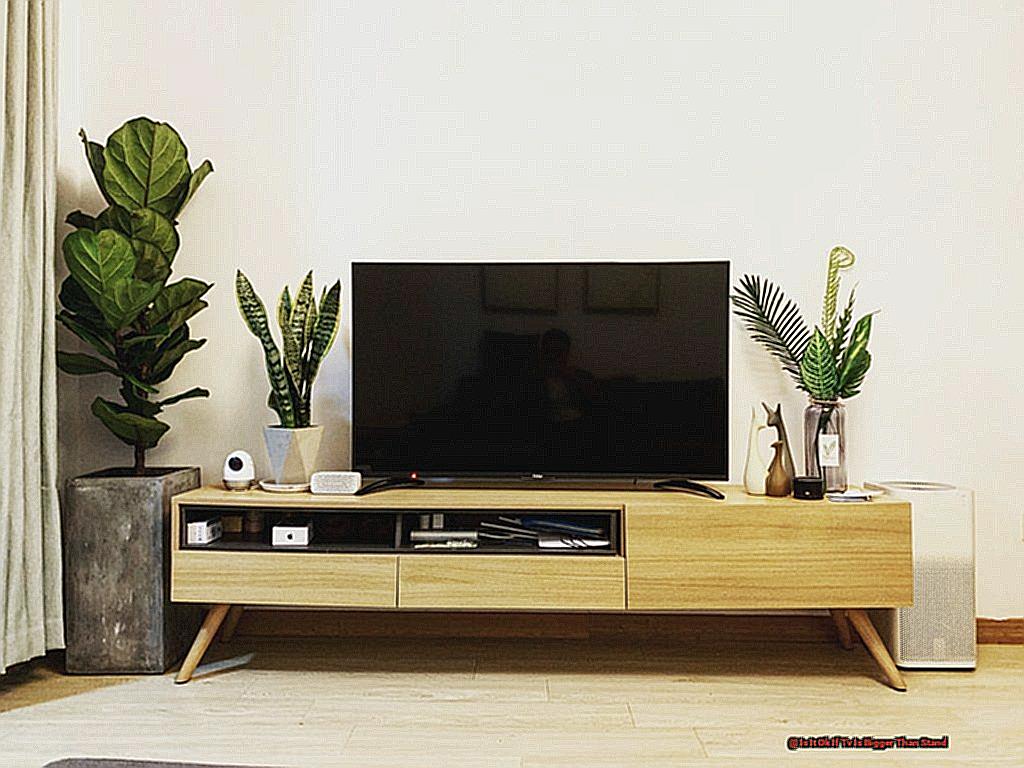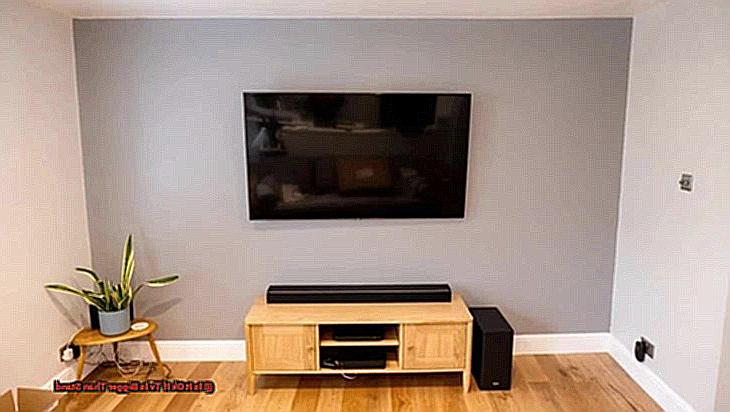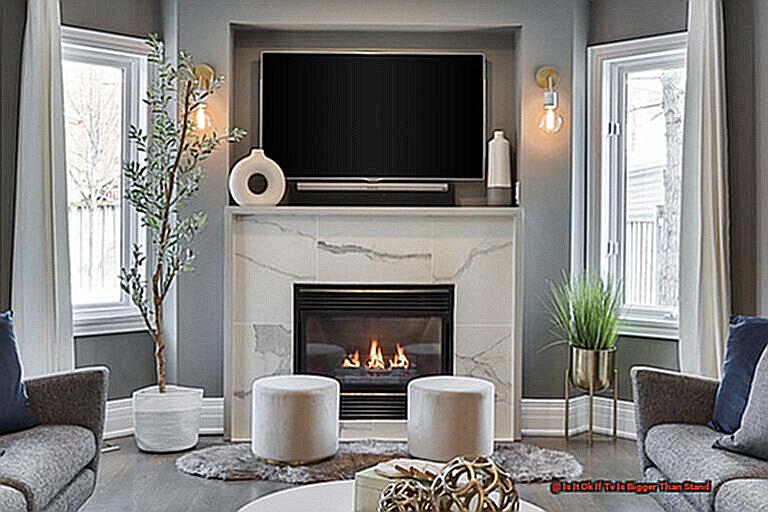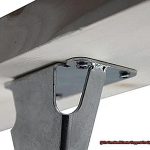Are you tired of straining your eyes and constantly adjusting your TV to get a better view? It may be time to upgrade to a larger TV. But before you make that purchase, there’s an important factor to consider – the size of your TV stand.
Don’t overlook this crucial aspect and end up with a mismatched setup that not only looks awkward but can also be hazardous. In this blog post, we’ll explore the question “is it ok if tv is bigger than stand” and provide valuable insights on:
- The importance of proper weight distribution
- Choosing the right size and style of TV stand
- Safety concerns and potential hazards
- Maximizing your viewing experience with a larger screen
So, get ready to elevate your entertainment game as we delve into the world of oversized TVs and how to find the perfect match for your setup. Let’s dive in.
Contents
Is It OK That My TV Is Bigger Than My TV Stand or Vice Versa?
When it comes to selecting the perfect TV stand for your television, there are a few key factors to take into consideration. The size ratio between the TV and the stand is crucial for not only its overall appearance but also its functionality. Here’s how you can determine the ideal size ratio:
- Measure your TV: The first step is to measure the width of your TV, including any protruding parts like stands or frames.
- Consider the viewing height: The ideal viewing height for a television is 42 inches, so be sure to choose a stand that positions the screen at this level. This will ensure comfortable viewing and prevent strain on your neck.
- Allow for proper ventilation: As TVs generate heat, it’s important to leave enough space around the sides and back of the television for proper air circulation. This also means leaving some room between the TV and the stand.
- Keep aesthetic balance in mind: A good rule of thumb is to have several inches of space on each edge of the TV stand compared to the width of the TV. This will create a visually pleasing and balanced look.
- Consider your room layout: The size and layout of your room should also be taken into account when determining the size of your TV stand. For smaller rooms, a larger stand may make the space feel cramped.
- Choose a sturdy stand: It’s crucial to ensure that your TV stand can support the weight of your television and any additional accessories, such as sound systems or gaming consoles.
By following these steps, you can determine the perfect size ratio between your TV and TV stand for optimal aesthetics and functionality. Additionally, keep in mind your budget, personal style preferences, and room layout when making your decision.
How to Measure Your TV for a TV Stand?
When determining if your TV is too large for your TV stand, there are several measurements to take into account. These include the size of the TV, the size of the stand, and the overall layout and dimensions of the room. Let’s break it down further:
TV Size:

The size of your TV is a crucial factor to consider when determining if it is too big for your stand. As mentioned earlier, the average TV size has significantly increased in recent years, with larger screens providing a more immersive viewing experience. However, it’s essential to strike a balance between screen size and room dimensions. A general rule of thumb is to have a TV that is no more than 75% of the width of your stand.
Stand Size:
The size of your TV stand is also critical in determining if your TV is too big. A good TV stand should be able to comfortably hold the weight of your TV and any additional accessories like soundbars or gaming consoles. It should also be wide enough to prevent tipping and provide stability for your TV.
Room Layout and Dimensions:
The layout and dimensions of your room play a significant role in determining if your TV is too big for your stand. Consider the seating arrangement and potential obstacles that may affect viewing angles when deciding on the size of your TV. Optimal viewing distance is also crucial for a comfortable and enjoyable viewing experience.
Screen Resolution:
Another factor to consider is the resolution of your TV. Higher resolutions like 4K and 8K can enhance the viewing experience on larger screens, but it’s important to maintain a comfortable eye level for extended periods.
So, when determining if a TV is too big for a stand, it’s essential to consider the size of the TV, the stand, and the overall room dimensions.
How To Find the Right TV Stand?
When trying to find the perfect TV stand for your television, there are a few important steps to follow:
Measure the height and width of your TV
Using a measuring tape, get the exact measurements of your TV’s height and width. This will give you an accurate starting point when looking for a suitable TV stand.
Consider the depth of your TV
Even flat panel TVs have depth, so be sure to measure this as well. This will help determine the minimum depth your TV stand should have to fit your TV comfortably.
Measure your room
Take note of the dimensions of your room, including any furniture or obstacles that may impact where you can place your TV stand.
Determine the best viewing distance
To ensure comfortable viewing, it’s recommended to sit at a distance of 1.5 to 2 times the diagonal screen size of your TV. For example, if you have a 55-inch TV, sitting 6-8 feet away is ideal.
Measure for eye level
Measure from the floor to the average eye level when seated, which is typically around 42 inches. Then, divide the height of your TV in half to determine the middle of the screen. Subtract this number from 42 inches to get an estimate of how tall your TV stand should be.
Find the diagonal measurement of your TV
Measure from the top left corner to the bottom right corner of your TV to get the diagonal measurement. This will help determine what size stand is most suitable for your TV.
Match the width of your TV with that of the stand
For both stability and aesthetics, it’s best to match the width of your TV with that of the stand. Ideally, a TV stand should be approximately 36 inches wide for larger TVs, while 20-24 inches is sufficient for smaller sets.
By following these steps and also considering the layout and dimensions of your room, you can determine the perfect size of a TV stand for your television.
What Are the Common TV Stand Sizes?
TV stands come in a variety of sizes, ranging from 32 inches to 60+ inches. There are also options available for corner placement and larger entertainment centers. To determine which size is best for your television, it’s important to consider the following factors:
- TV Width: Take the width of your TV and add 3-6 inches on each side for decorations. This will give you an estimate of the minimum width you should look for in a TV stand.
- Viewing Distance: The ideal height of a TV stand should allow for direct eye-level viewing when seated. To determine the appropriate height for your TV stand, measure the distance from the floor to the average sight line of a viewer.
- Depth: The depth of a TV stand depends on personal preference and the items that need to be accommodated. Options typically range from 14 inches to 24 inches.
- Corner Placement: If space is limited, consider a corner TV stand that can accommodate all standard TV sizes.
- Larger TVs: For TVs over 60 inches, it is recommended to use an entertainment center with a width of at least 58 inches and depth of at least 20 inches.
In general, it is recommended to choose a TV stand that is slightly longer than the width of your television for stability and aesthetics.
How Much Bigger Should My TV Stand Be Compared to My TV?

The perfect proportion between a television and its stand for the best functionality and aesthetics ranges from 1:1.5 to 1:1.8, implying that the width of the stand should be about 1.5 to 1.8 times longer than the TV’s width. This ratio allows ample space for the TV to sit comfortably on the stand while also leaving enough room for accessories and decorations.
However, it’s essential to note that this proportion can vary depending on individual preferences and the exact dimensions of both the TV and stand. For instance, a bigger TV may require a wider stand for stability, whereas a smaller TV may appear more appealing with a narrower stand.
Moreover, it’s crucial to consider the overall size of the room and the placement of the TV stand. For smaller rooms, a narrower stand might be more appropriate to avoid overcrowding the space. On the other hand, larger rooms can benefit from a wider stand for additional storage and decorative purposes.
Furthermore, the ideal height and depth of the stand significantly impact achieving optimal functionality and aesthetics. The height should be based on your average eye level when seated to ensure comfortable viewing, while the depth should accommodate any other devices such as gaming consoles or DVD players.
Is It Safe To Put a 55-Inch TV on a 50-Inch TV Stand?
The answer is not as simple as it may seem. Placing a larger and heavier TV on a smaller stand can have potential consequences, including instability, tipping over, and damage to both the TV and stand. Therefore, it is crucial to carefully evaluate the dimensions and weight of both the TV and stand before attempting this setup.
| Dimensions | 55-inch TV | 50-inch TV Stand |
| Width | 48.9 inches | 44.4 inches |
| Height | 28.5 inches | 25.6 inches |
| Depth | 2.1 inches | 8.5 inches |
| Total Weight | N/A | Approximately 35 lbs |
As evident from the table, the dimensions of a 55-inch TV far exceed those of a 50-inch TV stand, particularly in terms of width and height. This can result in an unsteady and top-heavy setup, making it vulnerable to tipping over. Additionally, the added weight of a larger TV can strain the stand, potentially causing it to break or collapse.
Besides safety concerns, placing a larger TV on a smaller stand can also affect the viewing experience. The optimal viewing distance for a 50-inch TV is approximately 7 feet, while for a 55-inch TV it is between 7.5 to 8 feet. Placing the TV on a smaller stand may not allow for sufficient distance, leading to discomfort and eye strain.
Furthermore, there are practical considerations to keep in mind when choosing between a 50-inch and 55-inch TV. As mentioned in the research notes, popular brands may have a limited availability of 50-inch TVs compared to larger ones. This is because manufacturers prioritize production of larger TVs due to their popularity and cost-effectiveness.
While it may be tempting to put a 55-inch TV on a 50-inch TV stand, it is not advisable due to potential risks and implications. Carefully evaluating the dimensions, weight, and viewing distance for both the TV and stand is crucial before making a decision.
Conclusion
In conclusion, it is crucial to carefully consider the size of your TV stand for both safety and optimal viewing experience.
Neglecting this aspect can result in a mismatched setup that not only looks awkward but also poses potential hazards. To ensure a perfect match, follow the steps outlined in this article, taking into account factors such as weight distribution, room layout, and personal preferences.
Remember to measure your TV, consider the viewing height and ventilation, and choose a sturdy stand that can support its weight. It is also important to note that placing a larger TV on a smaller stand may compromise safety and affect your viewing experience.
With these valuable insights in mind, elevate your entertainment game with a larger screen without sacrificing aesthetics or functionality.





